engine Lancia Musa 2010 Owner handbook (in English)
[x] Cancel search | Manufacturer: LANCIA, Model Year: 2010, Model line: Musa, Model: Lancia Musa 2010Pages: 218, PDF Size: 3.71 MB
Page 115 of 218
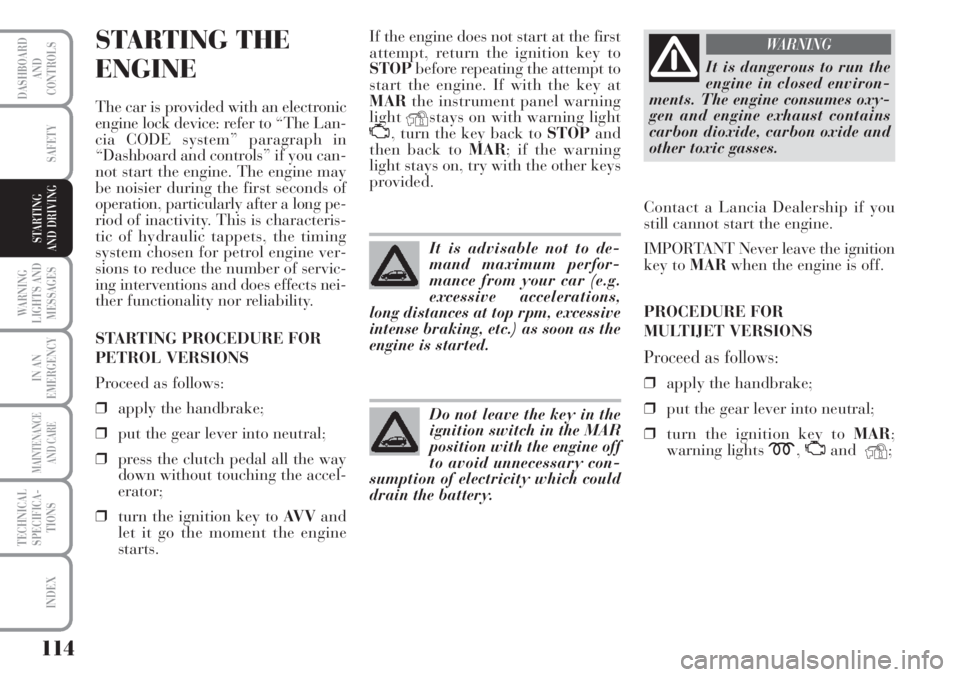
114
WARNING
LIGHTS AND
MESSAGES
IN AN
EMERGENCY
MAINTENANCE
AND CARE
TECHNICAL
SPECIFICA-
TIONS
INDEX
DASHBOARD
AND
CONTROLS
SAFETY
STARTING
AND DRIVING
STARTING THE
ENGINE
The car is provided with an electronic
engine lock device: refer to “The Lan-
cia CODE system” paragraph in
“Dashboard and controls” if you can-
not start the engine. The engine may
be noisier during the first seconds of
operation, particularly after a long pe-
riod of inactivity. This is characteris-
tic of hydraulic tappets, the timing
system chosen for petrol engine ver-
sions to reduce the number of servic-
ing interventions and does effects nei-
ther functionality nor reliability.
STARTING PROCEDURE FOR
PETROL VERSIONS
Proceed as follows:
❒apply the handbrake;
❒put the gear lever into neutral;
❒press the clutch pedal all the way
down without touching the accel-
erator;
❒turn the ignition key to AV Vand
let it go the moment the engine
starts.If the engine does not start at the first
attempt, return the ignition key to
STOPbefore repeating the attempt to
start the engine. If with the key at
MARthe instrument panel warning
lightYstays on with warning lightU, turn the key back to STOPand
then back to MAR; if the warning
light stays on, try with the other keys
provided.
It is dangerous to run the
engine in closed environ-
ments. The engine consumes oxy-
gen and engine exhaust contains
carbon dioxide, carbon oxide and
other toxic gasses.
WARNING
It is advisable not to de-
mand maximum perfor-
mance from your car (e.g.
excessive accelerations,
long distances at top rpm, excessive
intense braking, etc.) as soon as the
engine is started.
Do not leave the key in the
ignition switch in the MAR
position with the engine off
to avoid unnecessary con-
sumption of electricity which could
drain the battery.
Contact a Lancia Dealership if you
still cannot start the engine.
IMPORTANT Never leave the ignition
key to MARwhen the engine is off.
PROCEDURE FOR
MULTIJET VERSIONS
Proceed as follows:
❒apply the handbrake;
❒put the gear lever into neutral;
❒turn the ignition key to MAR;
warning lights m,
UandY;
Page 116 of 218
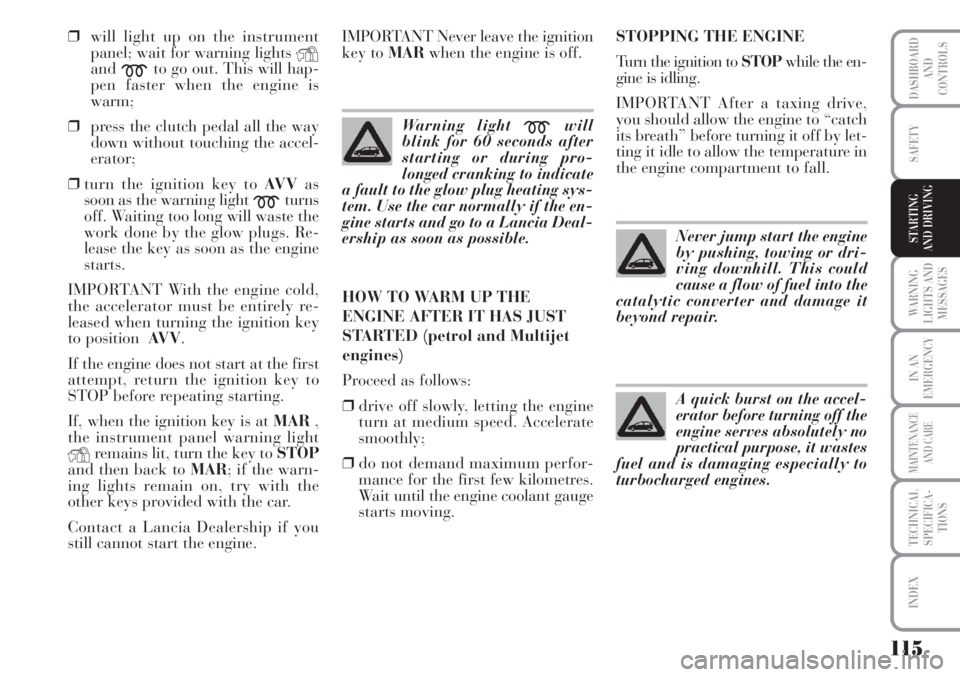
115
WARNING
LIGHTS AND
MESSAGES
IN AN
EMERGENCY
MAINTENANCE
AND CARE
TECHNICAL
SPECIFICA-
TIONS
INDEX
DASHBOARD
AND
CONTROLS
SAFETY
STARTING
AND DRIVING
❒will light up on the instrument
panel; wait for warning lights
Yand
mto go out. This will hap-
pen faster when the engine is
warm;
❒press the clutch pedal all the way
down without touching the accel-
erator;
❒turn the ignition key to AV Vas
soon as the warning light
mturns
off. Waiting too long will waste the
work done by the glow plugs. Re-
lease the key as soon as the engine
starts.
IMPORTANT With the engine cold,
the accelerator must be entirely re-
leased when turning the ignition key
to position AV V.
If the engine does not start at the first
attempt, return the ignition key to
STOP before repeating starting.
If, when the ignition key is at MAR,
the instrument panel warning light
Yremains lit, turn the key to STOP
and then back to MAR; if the warn-
ing lights remain on, try with the
other keys provided with the car.
Contact a Lancia Dealership if you
still cannot start the engine.HOW TO WARM UP THE
ENGINE AFTER IT HAS JUST
STARTED (petrol and Multijet
engines)
Proceed as follows:
❒drive off slowly, letting the engine
turn at medium speed. Accelerate
smoothly;
❒do not demand maximum perfor-
mance for the first few kilometres.
Wait until the engine coolant gauge
starts moving.Warning light
mwill
blink for 60 seconds after
starting or during pro-
longed cranking to indicate
a fault to the glow plug heating sys-
tem. Use the car normally if the en-
gine starts and go to a Lancia Deal-
ership as soon as possible.
STOPPING THE ENGINE
Turn the ignition to STOPwhile the en-
gine is idling.
IMPORTANT After a taxing drive,
you should allow the engine to “catch
its breath” before turning it off by let-
ting it idle to allow the temperature in
the engine compartment to fall.
Never jump start the engine
by pushing, towing or dri-
ving downhill. This could
cause a flow of fuel into the
catalytic converter and damage it
beyond repair.
A quick burst on the accel-
erator before turning off the
engine serves absolutely no
practical purpose, it wastes
fuel and is damaging especially to
turbocharged engines.
IMPORTANT Never leave the ignition
key to MARwhen the engine is off.
Page 117 of 218
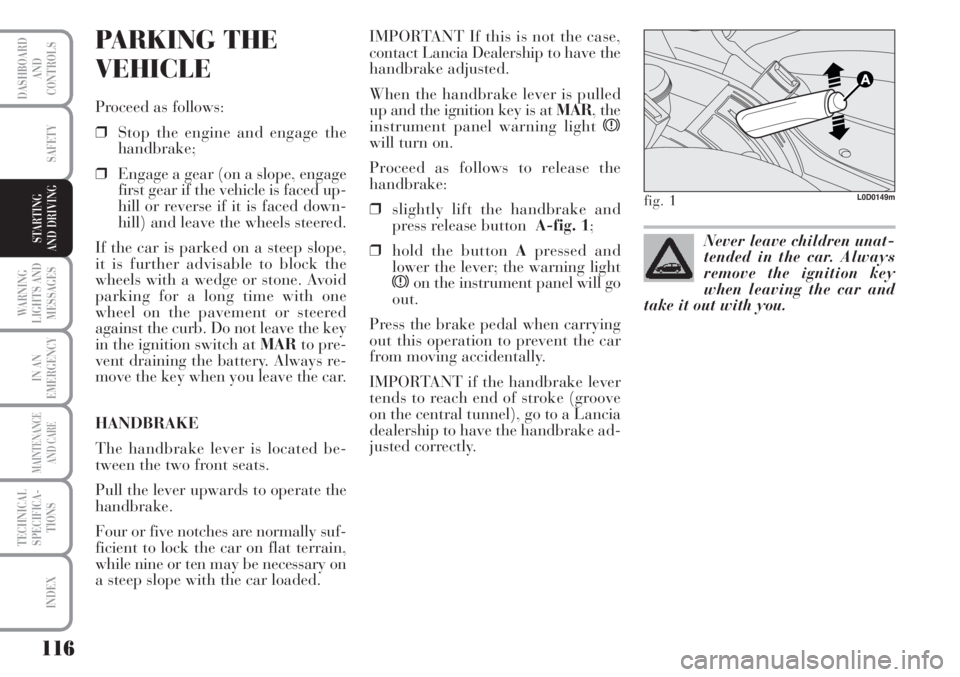
116
WARNING
LIGHTS AND
MESSAGES
IN AN
EMERGENCY
MAINTENANCE
AND CARE
TECHNICAL
SPECIFICA-
TIONS
INDEX
DASHBOARD
AND
CONTROLS
SAFETY
STARTING
AND DRIVING
PARKING THE
VEHICLE
Proceed as follows:
❒Stop the engine and engage the
handbrake;
❒Engage a gear (on a slope, engage
first gear if the vehicle is faced up-
hill or reverse if it is faced down-
hill) and leave the wheels steered.
If the car is parked on a steep slope,
it is further advisable to block the
wheels with a wedge or stone. Avoid
parking for a long time with one
wheel on the pavement or steered
against the curb. Do not leave the key
in the ignition switch at MARto pre-
vent draining the battery. Always re-
move the key when you leave the car.
HANDBRAKE
The handbrake lever is located be-
tween the two front seats.
Pull the lever upwards to operate the
handbrake.
Four or five notches are normally suf-
ficient to lock the car on flat terrain,
while nine or ten may be necessary on
a steep slope with the car loaded. IMPORTANT If this is not the case,
contact Lancia Dealership to have the
handbrake adjusted.
When the handbrake lever is pulled
up and the ignition key is at MAR, the
instrument panel warning light
xwill turn on.
Proceed as follows to release the
handbrake:
❒slightly lift the handbrake and
press release button A-fig. 1;
❒hold the button Apressed and
lower the lever; the warning light
xon the instrument panel will go
out.
Press the brake pedal when carrying
out this operation to prevent the car
from moving accidentally.
IMPORTANT if the handbrake lever
tends to reach end of stroke (groove
on the central tunnel), go to a Lancia
dealership to have the handbrake ad-
justed correctly.
fig. 1L0D0149m
Never leave children unat-
tended in the car. Always
remove the ignition key
when leaving the car and
take it out with you.
Page 118 of 218
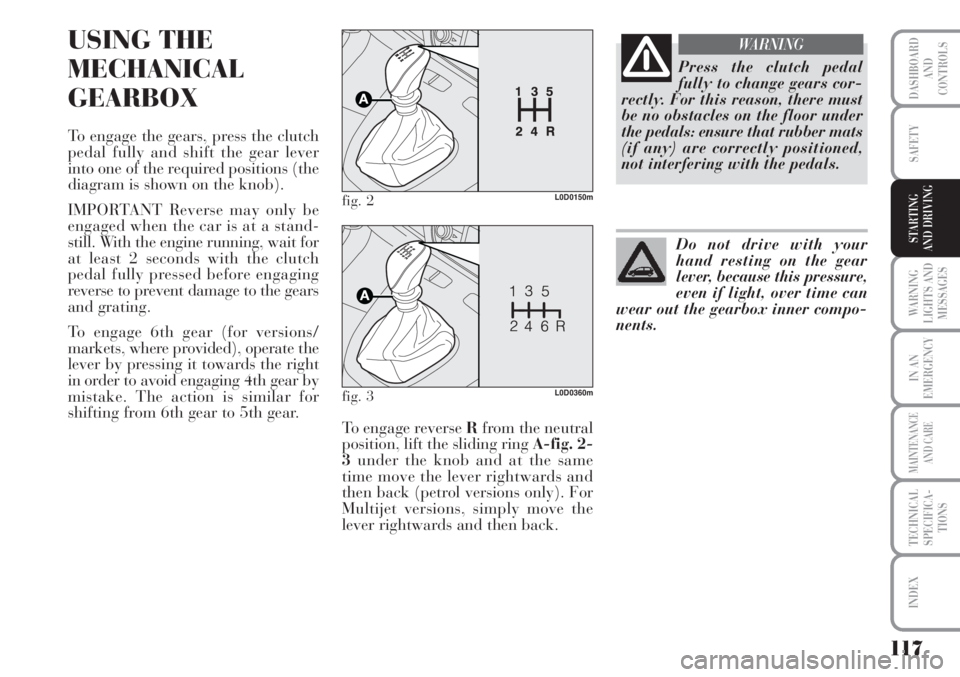
117
WARNING
LIGHTS AND
MESSAGES
IN AN
EMERGENCY
MAINTENANCE
AND CARE
TECHNICAL
SPECIFICA-
TIONS
INDEX
DASHBOARD
AND
CONTROLS
SAFETY
STARTING
AND DRIVING
USING THE
MECHANICAL
GEARBOX
To engage the gears, press the clutch
pedal fully and shift the gear lever
into one of the required positions (the
diagram is shown on the knob).
IMPORTANT Reverse may only be
engaged when the car is at a stand-
still. With the engine running, wait for
at least 2 seconds with the clutch
pedal fully pressed before engaging
reverse to prevent damage to the gears
and grating.
To engage 6th gear (for versions/
markets, where provided), operate the
lever by pressing it towards the right
in order to avoid engaging 4th gear by
mistake. The action is similar for
shifting from 6th gear to 5th gear.
To engage reverse Rfrom the neutral
position, lift the sliding ring A-fig. 2-
3under the knob and at the same
time move the lever rightwards and
then back (petrol versions only). For
Multijet versions, simply move the
lever rightwards and then back.
fig. 2L0D0150m
fig. 3L0D0360m
Do not drive with your
hand resting on the gear
lever, because this pressure,
even if light, over time can
wear out the gearbox inner compo-
nents.
Press the clutch pedal
fully to change gears cor-
rectly. For this reason, there must
be no obstacles on the floor under
the pedals: ensure that rubber mats
(if any) are correctly positioned,
not interfering with the pedals.
WARNING
Page 119 of 218
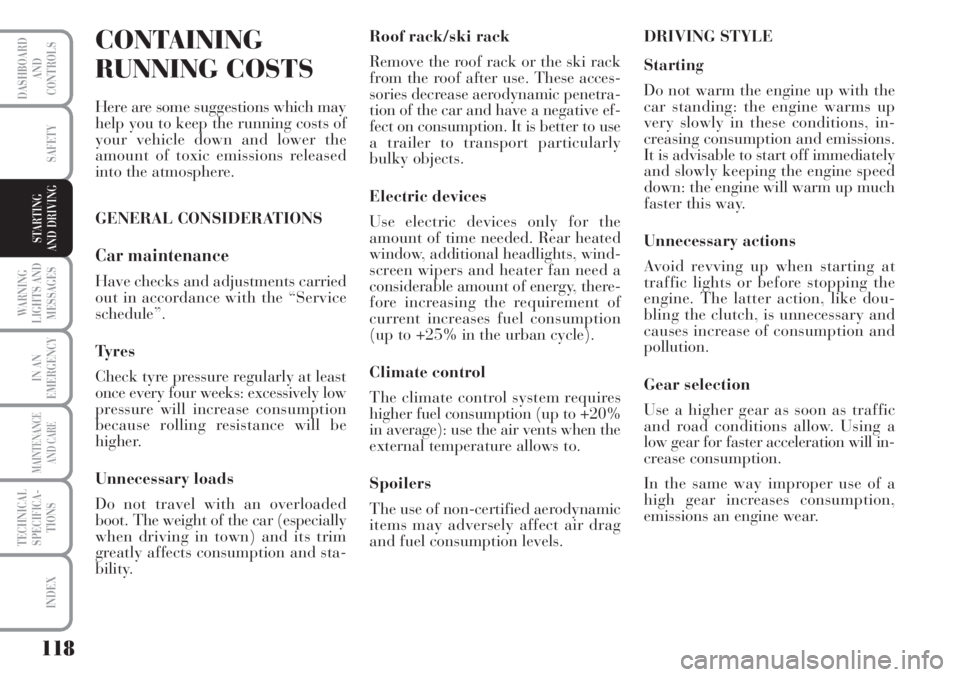
118
WARNING
LIGHTS AND
MESSAGES
IN AN
EMERGENCY
MAINTENANCE
AND CARE
TECHNICAL
SPECIFICA-
TIONS
INDEX
DASHBOARD
AND
CONTROLS
SAFETY
STARTING
AND DRIVING
CONTAINING
RUNNING COSTS
Here are some suggestions which may
help you to keep the running costs of
your vehicle down and lower the
amount of toxic emissions released
into the atmosphere.
GENERAL CONSIDERATIONS
Car maintenance
Have checks and adjustments carried
out in accordance with the “Service
schedule”.
Ty r e s
Check tyre pressure regularly at least
once every four weeks: excessively low
pressure will increase consumption
because rolling resistance will be
higher.
Unnecessary loads
Do not travel with an overloaded
boot. The weight of the car (especially
when driving in town) and its trim
greatly affects consumption and sta-
bility.Roof rack/ski rack
Remove the roof rack or the ski rack
from the roof after use. These acces-
sories decrease aerodynamic penetra-
tion of the car and have a negative ef-
fect on consumption. It is better to use
a trailer to transport particularly
bulky objects.
Electric devices
Use electric devices only for the
amount of time needed. Rear heated
window, additional headlights, wind-
screen wipers and heater fan need a
considerable amount of energy, there-
fore increasing the requirement of
current increases fuel consumption
(up to +25% in the urban cycle).
Climate control
The climate control system requires
higher fuel consumption (up to +20%
in average): use the air vents when the
external temperature allows to.
Spoilers
The use of non-certified aerodynamic
items may adversely affect air drag
and fuel consumption levels.DRIVING STYLE
Starting
Do not warm the engine up with the
car standing: the engine warms up
very slowly in these conditions, in-
creasing consumption and emissions.
It is advisable to start off immediately
and slowly keeping the engine speed
down: the engine will warm up much
faster this way.
Unnecessary actions
Avoid revving up when starting at
traffic lights or before stopping the
engine. The latter action, like dou-
bling the clutch, is unnecessary and
causes increase of consumption and
pollution.
Gear selection
Use a higher gear as soon as traffic
and road conditions allow. Using a
low gear for faster acceleration will in-
crease consumption.
In the same way improper use of a
high gear increases consumption,
emissions an engine wear.
Page 120 of 218
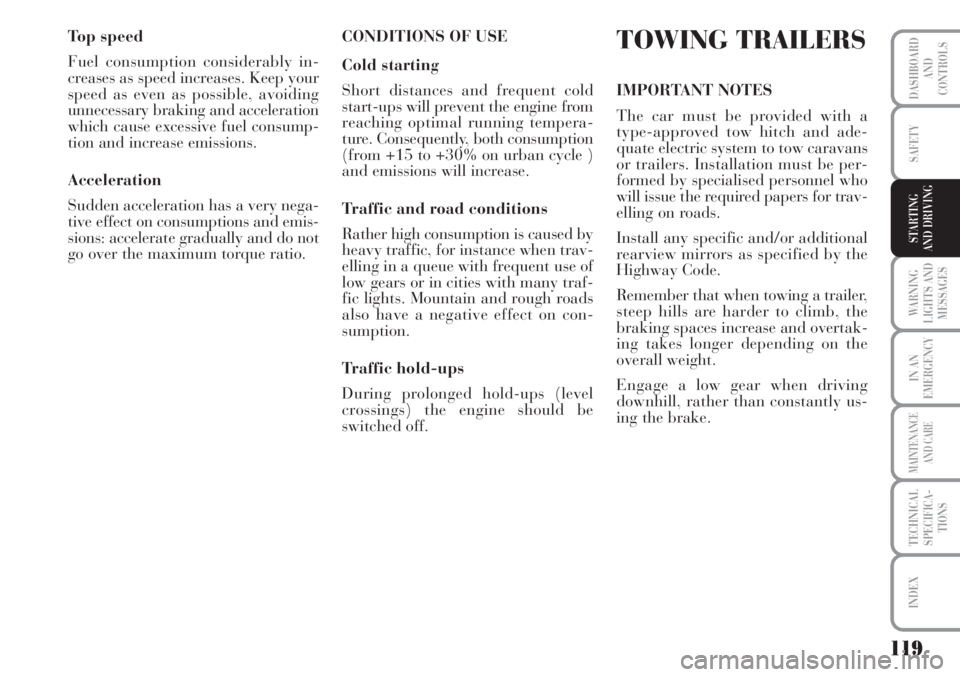
119
WARNING
LIGHTS AND
MESSAGES
IN AN
EMERGENCY
MAINTENANCE
AND CARE
TECHNICAL
SPECIFICA-
TIONS
INDEX
DASHBOARD
AND
CONTROLS
SAFETY
STARTING
AND DRIVING
Top speed
Fuel consumption considerably in-
creases as speed increases. Keep your
speed as even as possible, avoiding
unnecessary braking and acceleration
which cause excessive fuel consump-
tion and increase emissions.
Acceleration
Sudden acceleration has a very nega-
tive effect on consumptions and emis-
sions: accelerate gradually and do not
go over the maximum torque ratio.CONDITIONS OF USE
Cold starting
Short distances and frequent cold
start-ups will prevent the engine from
reaching optimal running tempera-
ture. Consequently, both consumption
(from +15 to +30% on urban cycle )
and emissions will increase.
Traffic and road conditions
Rather high consumption is caused by
heavy traffic, for instance when trav-
elling in a queue with frequent use of
low gears or in cities with many traf-
fic lights. Mountain and rough roads
also have a negative effect on con-
sumption.
Traffic hold-ups
During prolonged hold-ups (level
crossings) the engine should be
switched off.TOWING TRAILERS
IMPORTANT NOTES
The car must be provided with a
type-approved tow hitch and ade-
quate electric system to tow caravans
or trailers. Installation must be per-
formed by specialised personnel who
will issue the required papers for trav-
elling on roads.
Install any specific and/or additional
rearview mirrors as specified by the
Highway Code.
Remember that when towing a trailer,
steep hills are harder to climb, the
braking spaces increase and overtak-
ing takes longer depending on the
overall weight.
Engage a low gear when driving
downhill, rather than constantly us-
ing the brake.
Page 125 of 218
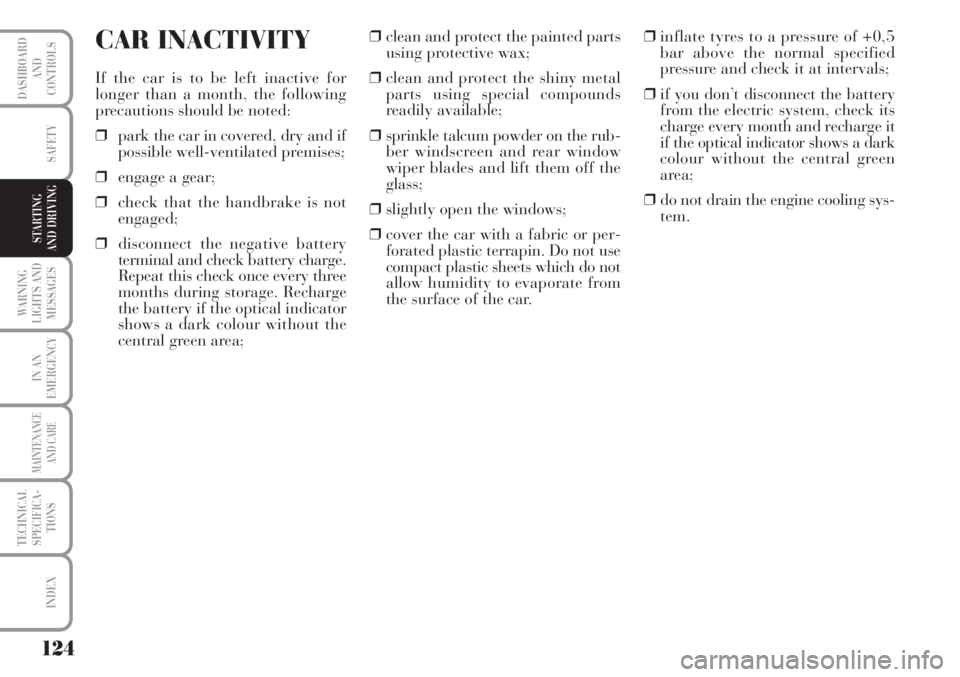
124
WARNING
LIGHTS AND
MESSAGES
IN AN
EMERGENCY
MAINTENANCE
AND CARE
TECHNICAL
SPECIFICA-
TIONS
INDEX
DASHBOARD
AND
CONTROLS
SAFETY
STARTING
AND DRIVING
CAR INACTIVITY
If the car is to be left inactive for
longer than a month, the following
precautions should be noted:
❒park the car in covered, dry and if
possible well-ventilated premises;
❒engage a gear;
❒check that the handbrake is not
engaged;
❒disconnect the negative battery
terminal and check battery charge.
Repeat this check once every three
months during storage. Recharge
the battery if the optical indicator
shows a dark colour without the
central green area;❒clean and protect the painted parts
using protective wax;
❒clean and protect the shiny metal
parts using special compounds
readily available;
❒sprinkle talcum powder on the rub-
ber windscreen and rear window
wiper blades and lift them off the
glass;
❒slightly open the windows;
❒cover the car with a fabric or per-
forated plastic terrapin. Do not use
compact plastic sheets which do not
allow humidity to evaporate from
the surface of the car.❒inflate tyres to a pressure of +0,5
bar above the normal specified
pressure and check it at intervals;
❒if you don’t disconnect the battery
from the electric system, check its
charge every month and recharge it
if the optical indicator shows a dark
colour without the central green
area;
❒do not drain the engine cooling sys-
tem.
Page 126 of 218
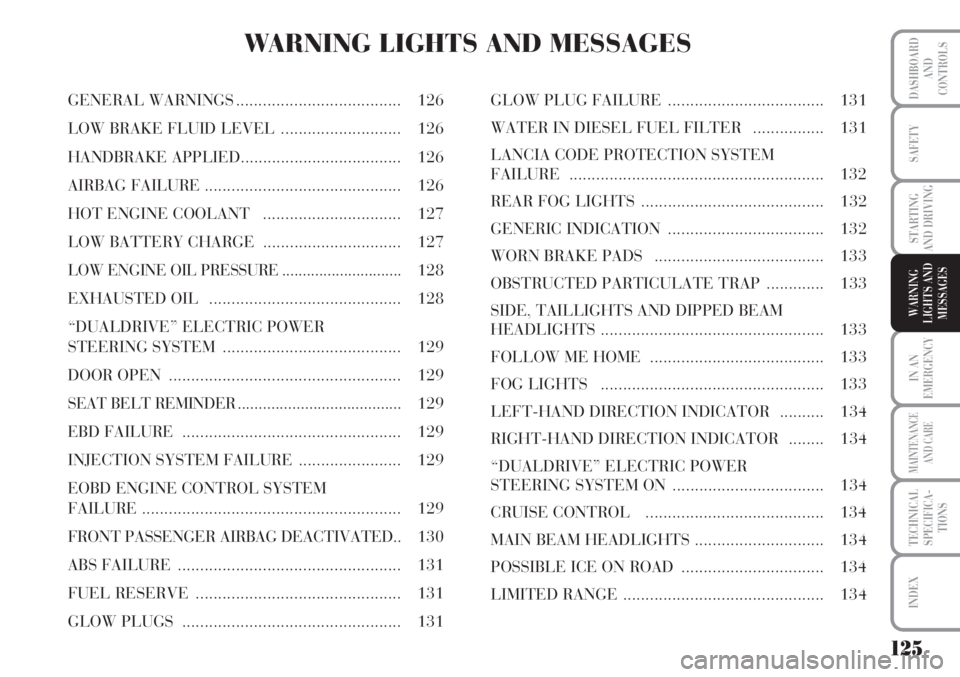
125
IN AN
EMERGENCY
MAINTENANCE
AND CARE
TECHNICAL
SPECIFICA-
TIONS
INDEX
DASHBOARD
AND
CONTROLS
SAFETY
STARTING
AND DRIVING
WARNING
LIGHTS AND
MESSAGES
WARNING LIGHTS AND MESSAGES
GENERAL WARNINGS..................................... 126
LOW BRAKE FLUID LEVEL ........................... 126
HANDBRAKE APPLIED.................................... 126
AIRBAG FAILURE............................................ 126
HOT ENGINE COOLANT............................... 127
LOW BATTERY CHARGE ............................... 127
LOW ENGINE OIL PRESSURE.............................128
EXHAUSTED OIL ........................................... 128
“DUALDRIVE” ELECTRIC POWER
STEERING SYSTEM ........................................ 129
DOOR OPEN .................................................... 129
SEAT BELT REMINDER....................................... 129
EBD FAILURE ................................................. 129
INJECTION SYSTEM FAILURE....................... 129
EOBD ENGINE CONTROL SYSTEM
FAILURE.......................................................... 129
FRONT PASSENGER AIRBAG DEACTIVATED.. 130
ABS FAILURE .................................................. 131
FUEL RESERVE .............................................. 131
GLOW PLUGS ................................................. 131GLOW PLUG FAILURE................................... 131
WATER IN DIESEL FUEL FILTER ................ 131
LANCIA CODE PROTECTION SYSTEM
FAILURE ......................................................... 132
REAR FOG LIGHTS ......................................... 132
GENERIC INDICATION ................................... 132
WORN BRAKE PADS ...................................... 133
OBSTRUCTED PARTICULATE TRAP ............. 133
SIDE, TAILLIGHTS AND DIPPED BEAM
HEADLIGHTS .................................................. 133
FOLLOW ME HOME ....................................... 133
FOG LIGHTS .................................................. 133
LEFT-HAND DIRECTION INDICATOR .......... 134
RIGHT-HAND DIRECTION INDICATOR ........ 134
“DUALDRIVE” ELECTRIC POWER
STEERING SYSTEM ON .................................. 134
CRUISE CONTROL ........................................ 134
MAIN BEAM HEADLIGHTS ............................. 134
POSSIBLE ICE ON ROAD ................................ 134
LIMITED RANGE ............................................. 134
Page 128 of 218
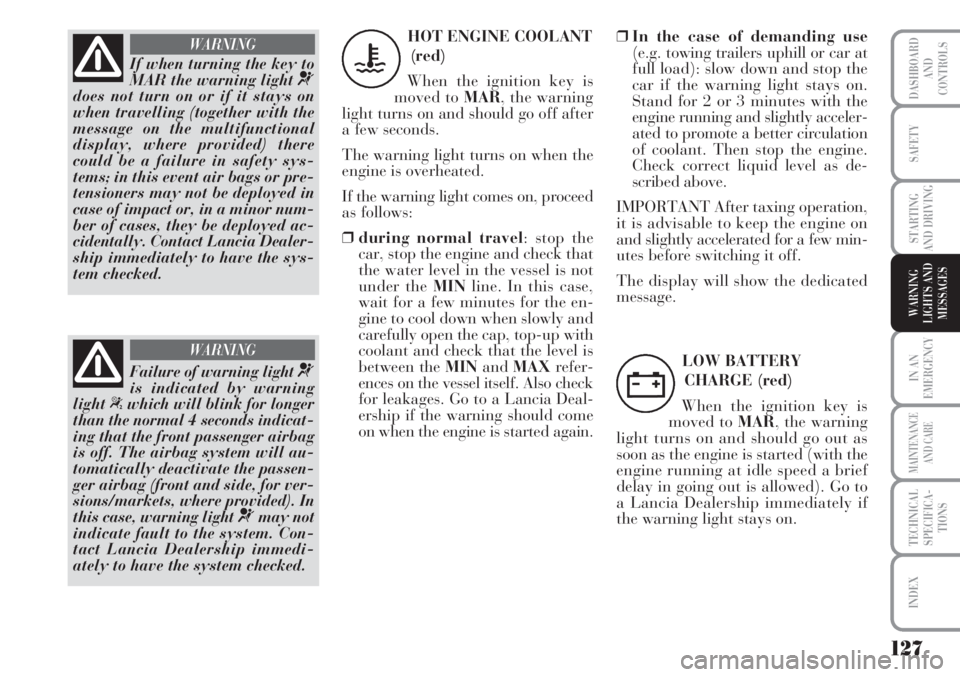
127
IN AN
EMERGENCY
MAINTENANCE
AND CARE
TECHNICAL
SPECIFICA-
TIONS
INDEX
DASHBOARD
AND
CONTROLS
SAFETY
STARTING
AND DRIVING
WARNING
LIGHTS AND
MESSAGES
If when turning the key to
MAR the warning light ¬does not turn on or if it stays on
when travelling (together with the
message on the multifunctional
display, where provided) there
could be a failure in safety sys-
tems; in this event air bags or pre-
tensioners may not be deployed in
case of impact or, in a minor num-
ber of cases, they be deployed ac-
cidentally. Contact Lancia Dealer-
ship immediately to have the sys-
tem checked.
Failure of warning light
¬is indicated by warning
light“which will blink for longer
than the normal 4 seconds indicat-
ing that the front passenger airbag
is off. The airbag system will au-
tomatically deactivate the passen-
ger airbag (front and side, for ver-
sions/markets, where provided). In
this case, warning light
¬may not
indicate fault to the system. Con-
tact Lancia Dealership immedi-
ately to have the system checked.
WARNING
WARNING
HOT ENGINE COOLANT
(red)
When the ignition key is
moved to MAR, the warning
light turns on and should go off after
a few seconds.
The warning light turns on when the
engine is overheated.
If the warning light comes on, proceed
as follows:
❒during normal travel: stop the
car, stop the engine and check that
the water level in the vessel is not
under the MINline. In this case,
wait for a few minutes for the en-
gine to cool down when slowly and
carefully open the cap, top-up with
coolant and check that the level is
between the MINandMAXrefer-
ences on the vessel itself. Also check
for leakages. Go to a Lancia Deal-
ership if the warning should come
on when the engine is started again.
u
❒In the case of demanding use
(e.g. towing trailers uphill or car at
full load): slow down and stop the
car if the warning light stays on.
Stand for 2 or 3 minutes with the
engine running and slightly acceler-
ated to promote a better circulation
of coolant. Then stop the engine.
Check correct liquid level as de-
scribed above.
IMPORTANT After taxing operation,
it is advisable to keep the engine on
and slightly accelerated for a few min-
utes before switching it off.
The display will show the dedicated
message.
LOW BATTERY
CHARGE (red)
When the ignition key is
moved to MAR, the warning
light turns on and should go out as
soon as the engine is started (with the
engine running at idle speed a brief
delay in going out is allowed). Go to
a Lancia Dealership immediately if
the warning light stays on.
w
Page 129 of 218
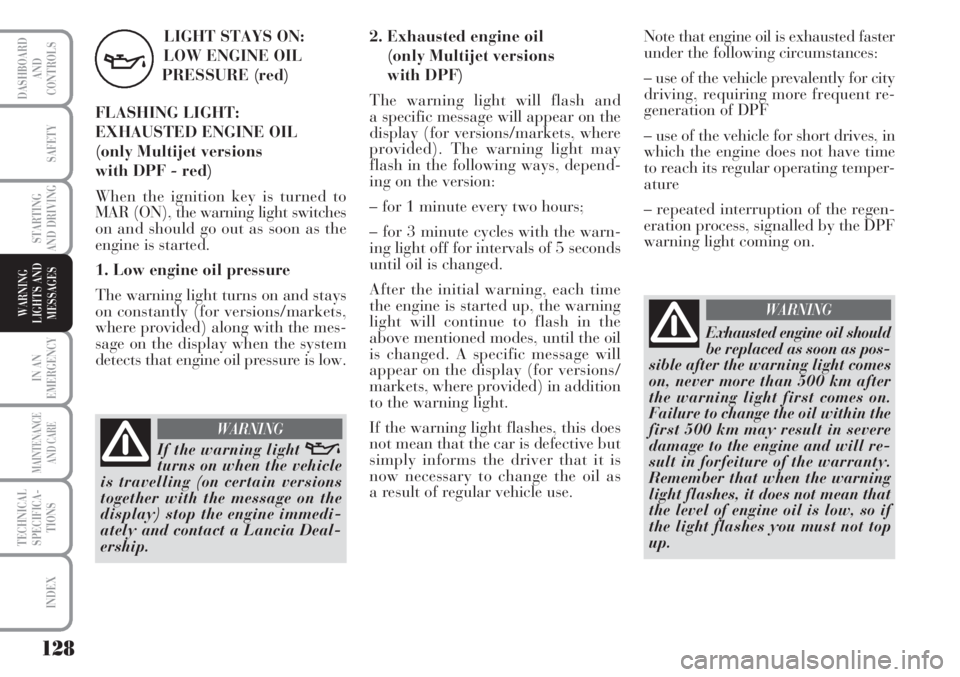
128
IN AN
EMERGENCY
MAINTENANCE
AND CARE
TECHNICAL
SPECIFICA-
TIONS
INDEX
DASHBOARD
AND
CONTROLS
SAFETY
STARTING
AND DRIVING
WARNING
LIGHTS AND
MESSAGES
LIGHT STAYS ON:
LOW ENGINE OIL
PRESSURE (red)
FLASHING LIGHT:
EXHAUSTED ENGINE OIL
(only Multijet versions
with DPF - red)
When the ignition key is turned to
MAR (ON), the warning light switches
on and should go out as soon as the
engine is started.
1. Low engine oil pressure
The warning light turns on and stays
on constantly (for versions/markets,
where provided) along with the mes-
sage on the display when the system
detects that engine oil pressure is low.
v
2. Exhausted engine oil
(only Multijet versions
with DPF)
The warning light will flash and
a specific message will appear on the
display (for versions/markets, where
provided). The warning light may
flash in the following ways, depend-
ing on the version:
– for 1 minute every two hours;
– for 3 minute cycles with the warn-
ing light off for intervals of 5 seconds
until oil is changed.
After the initial warning, each time
the engine is started up, the warning
light will continue to flash in the
above mentioned modes, until the oil
is changed. A specific message will
appear on the display (for versions/
markets, where provided) in addition
to the warning light.
If the warning light flashes, this does
not mean that the car is defective but
simply informs the driver that it is
now necessary to change the oil as
a result of regular vehicle use.
If the warning light v
turns on when the vehicle
is travelling (on certain versions
together with the message on the
display) stop the engine immedi-
ately and contact a Lancia Deal-
ership.
WARNING
Note that engine oil is exhausted faster
under the following circumstances:
– use of the vehicle prevalently for city
driving, requiring more frequent re-
generation of DPF
– use of the vehicle for short drives, in
which the engine does not have time
to reach its regular operating temper-
ature
– repeated interruption of the regen-
eration process, signalled by the DPF
warning light coming on.
WARNING
Exhausted engine oil should
be replaced as soon as pos-
sible after the warning light comes
on, never more than 500 km after
the warning light first comes on.
Failure to change the oil within the
first 500 km may result in severe
damage to the engine and will re-
sult in forfeiture of the warranty.
Remember that when the warning
light flashes, it does not mean that
the level of engine oil is low, so if
the light flashes you must not top
up.